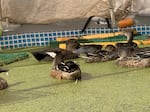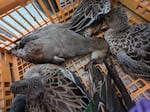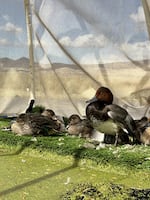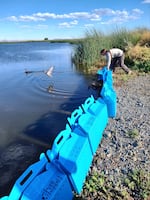On a clear, sunny day in early October, January Bill peers under a drop cloth at the latest batch of patients at the Bird Ally X field hospital near the Oregon-California border. The birds—American wigeons, shovelers, and Northern pintails—are clearly sick: Some struggle weakly; some don’t move at all.
“They’re at different degrees of paralysis,” says Bill, a wildlife rehabilitator who co-founded Bird Ally X. “We rate it by a stage from one to four, with four being the worst; they are usually 100 percent paralyzed.”

Ducks recovering from botulism have access to "micro-habitats" that mimic natural wetlands.
Courtesy of birdallyx.net / JPR
These ducks are victims of a large outbreak of avian botulism that so far has killed close to 100,000 birds at the Tule Lake National Wildlife Refuge. Botulism is produced by a soil bacterium that thrives in warm, shallow water and newly exposed soil. The botulism toxin works by interrupting nerve transmission. Afflicted birds lose the ability to walk, then fly, then to move at all.
A nonprofit network of wildlife rehabilitators, Bird Ally X has set up a M*A*S*H-style field hospital in and around a large carport to treat the birds. Inside, staff and volunteers work in pairs, treating birds that can still move. Working quietly, one person holds a swaddled bird while the other takes a temperature, attaches a leg band, and notes the species and stage of disease.
At a separate station, Lana Battaglia attends to the sickest patients, including an American wigeon that’s completely paralyzed — a “four.” She gently inserts a needle into the bird’s leg and depresses the plunger of a syringe. The goal is to get about 1 cc of fluids into the bird’s system.
“It’s really phenomenal how the basic treatments that they’re getting here can help support them through the process,” says Battaglia, who is an expert in oiled wildlife response.
The wigeon she is treating has about a 50/50 chance of surviving. Birds captured at earlier stages have a much better prognosis.

When sick birds first come in, many are completely paralyzed and can't even hold their heads up.
Courtesy of birdallyx.net / JPR
After intake, the birds that can at least lift their heads are given a tube feeding that includes dextrose for energy and Vitamin B complex, which helps regenerate nerves. Then they’re placed in special boxes to recover. The boxes are fitted with towels that serve as “keel protectors,” preventing a bird’s sharp breast bone from rubbing against the box where it could develop lesions.
“From there, we don’t touch them for the rest of the day,” says Bill. “It’s a very traumatic experience for them I imagine.”
Bill and Travers launched Bird Ally X Botulism Response in 2018 after being asked to treat birds during a botulism outbreak at the Klamath Refuges. They returned to the refuges in 2019 and 2020, when the worst outbreak in refuge history killed at least 60,000 birds.
Earlier this month, refuge staff were picking up an average of 800 dead birds a day, John Vradenburg, supervisory biologist at the Klamath Basin Refuge Complexes.–a sad end to a summer that began with celebration of the birds’ return to the refuges..
Earlier this summer, after receiving the first meaningful water deliveries in several years, wetlands in the Tule Lake and Lower Klamath refuges were thronged with birds.The refuges rely on water distributed through the Klamath Project, which is managed by the federal Bureau of Reclamation. But once the allocated water stopped flowing and temperatures rose, the risk of botulism grew. Some believe an outbreak could have been avoided altogether if the refuges had received additional water in time.

Lana Battaglia injects fluids into the leg of a very sick American Wigeon.
Juliet Grable / JPR
Bird Ally X was one of 16 conservation groups that signed on to an August 9 letter urging the Bureau of Reclamation to deliver water to the refuges to mitigate the outbreak. Separately, irrigators and tribes sent their own letters. The Bureau did deliver more water to the refuges in late August, but by then, birds had already begun to die.
However, Vradenburg says the water delivery helped prevent an even greater disaster by flooding additional wetlands and spreading the birds over more habitat.
“Many of those areas hadn’t been affected by botulism, so they had clean areas to go to,” he explains.
In September, the Bureau of Reclamation released its draft Environmental Assessment on the operation of the Klamath Project, which allocates Klamath Basin water to irrigators. Its proposed action includes, for the first time, a dedicated supply of water for the refuges.
Though not guaranteed to be retained in the final plan, the change in allocation is a hopeful sign that the agency intends to pursue an “ecosystem approach” to water management, says Vradenburg. “It’s a very positive thing to see a dedication of water to the refuge as an acknowledgment that they’re important and resources need to be prioritized to support the benefits of the refuges,” he says. Meanwhile, there’s no immediate relief to the current outbreak.
“Until we freeze, it’s just going to be persistent at this point,” says Vradenburg. Freezing temperatures arrest the reproduction of flies, which breed on the carcasses of birds that have succumbed to the disease.

Ducks recover together in outdoor "sun pens" until they are able to fly.
Courtesy of birdallyx.net / JPR
Unfortunately, the lingering outbreak is starting to affect birds that are stopping at the refuges on their southward migration–something he saw in the 2020 outbreak, too.
“As we’re seeing these climate shifts and later and later onsets of first freeze, it’s starting to overlap with the first part of fall migration,” says Vradenburg.
The sickened birds that make it to the Bird Ally X field hospital are the lucky ones.
Once birds have recovered overnight, they can join other birds in one of several conditioning pools, including “sun pens” located outside the carport. These kiddie pools, topped with a dome of netting for shade and privacy, are designed to mimic natural conditions: birds have access to water and food, but they can also “haul out” to dryer ground where they can preen and rest.
Marie Travers, co-manager of Bird Ally X botulism response, moves from one domed enclosure to the next. As she peeks under the netting at one, a cluster of ducks—wigeons, pintails, and a pair of shovelers—preen and waggle their tails.
“I’m just looking for birds that can’t get off the haul-out because they don’t have the strength or recovery time yet,” she explains. “Almost all of these birds are standing, so that means they’re pretty far along in their recovery.”
In a day or so, these birds will be released in Unit 2 of the Lower Klamath Refuge, which so far has not been affected by the outbreak.
The Bird Ally X operation has wrapped up this week, but not because the outbreak is over. Hunting season has begun, and refuge staff can’t safely deploy their airboats into the wetlands to collect new patients.
In total, thanks to help from professional wildlife rehabilitators, interns, and volunteers from advocacy organizations like the Bird Alliance of Oregon, Bird Ally X has rehabilitated and released more than 900 birds. They’ve treated 27 different species, from geese and ducks to shorebirds like ibis, black-necked stilts and dowitchers. Their operation has also helped train responders from across the country.
“Since 2018, after we did our first response, we have been going to conferences and trying to present on how we did the operation to show other rehab organizations how you can collaborate with other agencies during large emergencies and care for large numbers of birds with very few resources,” says Bill.

If treated in time, birds afflicted with botulism can recover completely and be released back into the wild.
Courtesy of birdallyx.net / JPR
She hopes their work will help drive more support for prioritizing wildlife when decisions about allocating water are made. Meanwhile, the mission and her colleagues keep her motivated to help as many birds as she can.
“Since it’s human caused, I just feel like we have an obligation to treat them,” says Bill. “And individuals do matter.”
This story comes to you from the Northwest News Network, a collaboration between public media organizations in Oregon and Washington.


